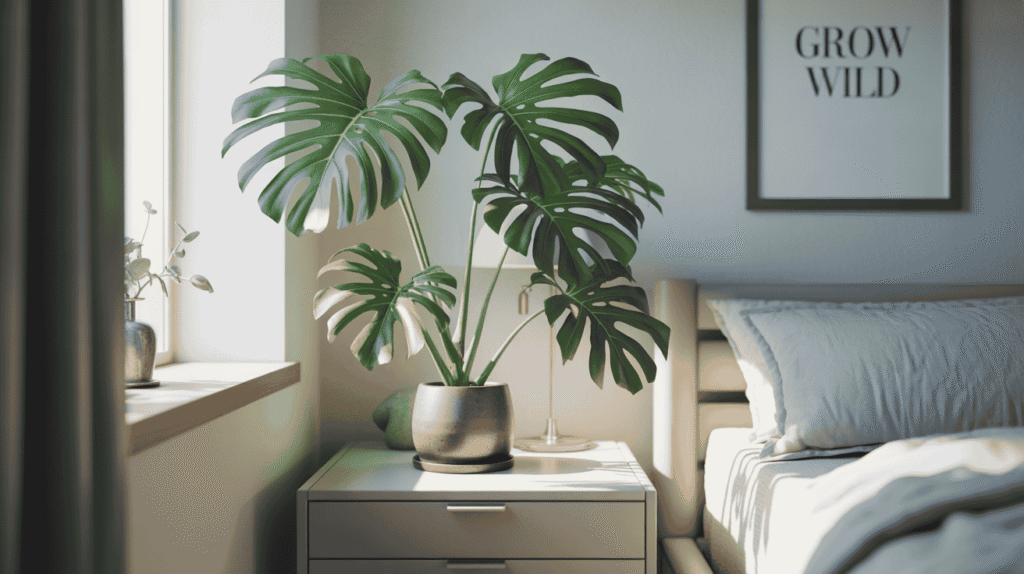Imagine walking into your bedroom after a long day. Instead of just being a place to sleep, your room greets you with a calming, refreshing vibe—thanks to lush green indoor plants. 🌱 These leafy companions don’t just look beautiful; they purify the air, reduce stress, and even improve your sleep quality.
Bedrooms are personal sanctuaries where we recharge, and filling them with the right plants can transform them into healthier, more serene spaces. Whether you live in a small apartment or a spacious home, there’s an indoor plant that can suit your bedroom’s lighting, style, and care routine.
In this guide, we’ll explore the best indoor plants for bedrooms, their benefits, how to care for them, and practical tips for making your room feel like a peaceful indoor jungle.
Why Choose Indoor Plants for Bedrooms?
1. Cleaner, Fresher Air
Plants absorb toxins and release oxygen, creating a healthier sleeping environment. Some plants, like the Snake Plant, even release oxygen at night.
2. Stress Relief & Mental Calmness
Studies show that greenery reduces stress and promotes relaxation—perfect for unwinding before bedtime.
3. Better Sleep Quality
Certain plants help regulate humidity, release soothing scents, or filter out harmful chemicals that might disturb sleep.
4. Natural Aesthetic Appeal
Indoor plants make bedrooms look stylish, cozy, and welcoming without much effort.
Best Indoor Plants for Bedrooms
Let’s look at the top air-purifying, low-maintenance plants that thrive indoors and are ideal for bedrooms.
1. Snake Plant (Sansevieria trifasciata)
- Why it’s great for bedrooms: Releases oxygen at night, unlike most plants that do so only during the day.
- Care tips: Thrives in low light and requires minimal watering.
- Bonus: Known for absorbing toxins like formaldehyde and benzene.
2. Peace Lily (Spathiphyllum)
- Why it’s great for bedrooms: Improves air quality and raises humidity levels, reducing dry air issues.
- Care tips: Keep soil slightly moist; prefers medium to low light.
- Bonus: Elegant white flowers add a peaceful, luxurious touch.
3. Aloe Vera
- Why it’s great for bedrooms: Purifies air and provides natural gel for burns and skin care.
- Care tips: Needs bright, indirect sunlight and little water.
- Bonus: Also releases oxygen at night for improved sleep quality.
4. Spider Plant (Chlorophytum comosum)
- Why it’s great for bedrooms: Excellent at removing pollutants like carbon monoxide and formaldehyde.
- Care tips: Grows well in hanging baskets; loves indirect light.
- Bonus: Produces baby “spiderettes” you can propagate.
5. Lavender (Lavandula)
- Why it’s great for bedrooms: Famous for its calming scent, which reduces anxiety and promotes sleep.
- Care tips: Needs bright sunlight and well-draining soil.
- Bonus: Works as natural aromatherapy right in your room.
6. Jasmine (Jasminum)
- Why it’s great for bedrooms: Sweet fragrance helps reduce stress and encourage deeper sleep.
- Care tips: Prefers bright, indirect sunlight and regular watering.
- Bonus: Adds a romantic and fresh vibe.
7. English Ivy (Hedera helix)
- Why it’s great for bedrooms: NASA found it effective in reducing airborne mold.
- Care tips: Needs indirect light and moderate watering.
- Bonus: Perfect for hanging planters or shelves.
8. Areca Palm (Dypsis lutescens)
- Why it’s great for bedrooms: Acts as a natural humidifier while filtering toxins.
- Care tips: Place in bright, indirect light; keep soil moist.
- Bonus: Adds a tropical vibe to your sleeping space.
9. Rubber Plant (Ficus elastica)
- Why it’s great for bedrooms: Absorbs toxins and adds bold greenery with its glossy leaves.
- Care tips: Loves indirect light and moderate watering.
- Bonus: Ideal for modern bedroom décor.
10. Chamomile (Matricaria chamomilla)
- Why it’s great for bedrooms: Known for its calming aroma, often used in teas for sleep.
- Care tips: Needs sunlight and regular watering.
- Bonus: Provides a soft, cottage-core feel.
Choosing the Right Bedroom Plant
When selecting plants, consider these factors:
Light Levels
- Low-light bedrooms: Snake Plant, Peace Lily, Spider Plant.
- Bright bedrooms: Aloe Vera, Lavender, Jasmine.
Bedroom Size
- Small spaces: Hanging Spider Plants or Ivy.
- Larger rooms: Rubber Plant, Areca Palm.
Maintenance Level
- Low-maintenance options: Snake Plant, Aloe Vera, Peace Lily.
- Slightly demanding options: Lavender, Jasmine.
How to Care for Indoor Bedroom Plants
Watering
- Avoid overwatering—check soil moisture before watering.
- Most indoor plants prefer slightly dry conditions between waterings.
Light Placement
- Position near windows but avoid harsh, direct sunlight.
- For darker rooms, choose low-light-tolerant plants.
Humidity & Temperature
- Some plants (like ferns and palms) love humidity, making them perfect for bathrooms adjacent to bedrooms.
- Use a pebble tray or humidifier if your room is dry.
Potting & Soil
- Use well-draining soil and pots with drainage holes.
- Repot every 1–2 years to encourage healthy growth.
Cleaning & Maintenance
- Dust leaves every 2–3 weeks.
- Trim yellowing or dead leaves to encourage new growth.
Styling Your Bedroom with Indoor Plants
- Bedside Table Plants: Place Aloe Vera or Lavender for beauty and health benefits.
- Hanging Planters: Use Spider Plants or Ivy to save space.
- Floor Plants: Rubber Plant or Areca Palm adds a bold, decorative touch.
- Window Sills: Perfect for sun-loving plants like Jasmine or Chamomile.
Benefits of Indoor Plants in Bedrooms
- Air purification – Removes toxins and improves oxygen flow.
- Stress reduction – Greenery and calming scents promote relaxation.
- Improved sleep – Plants like Snake Plant and Lavender support deeper rest.
- Moisture regulation – Humidity-loving plants keep air from getting too dry.
- Enhanced décor – Brings freshness, coziness, and natural beauty.
Step-by-Step Guide to Creating a Plant-Friendly Bedroom
- Assess your room – Note lighting, space, and humidity.
- Pick starter plants – Choose easy-care options like Snake Plant or Spider Plant.
- Choose the right pots – Go for stylish pots that match your bedroom theme.
- Arrange thoughtfully – Mix small tabletop plants with taller floor plants.
- Set a routine – Water, wipe, and prune regularly for healthy plants.
Common Problems and Quick Fixes
- Leaves turning yellow: Overwatering—let soil dry out.
- Brown tips: Low humidity or poor water quality—try filtered water.
- Drooping leaves: Lack of light or inconsistent watering.
- Pests: Use neem oil or natural insect sprays.
FAQs About Indoor Bedroom Plants
1. Are indoor plants safe to keep in bedrooms at night?
Yes, many plants are safe. Some, like Snake Plant and Aloe Vera, release oxygen at night, making them perfect for bedrooms.
2. Which plant is best for better sleep?
Lavender, Jasmine, and Peace Lily are great options for promoting relaxation and restful sleep.
3. Do indoor plants attract insects in bedrooms?
Not if properly cared for. Overwatering can cause pests, so maintain proper watering habits.
4. How many plants should I keep in a bedroom?
1–3 medium-sized plants are enough for most bedrooms. Larger rooms can accommodate more.
5. Can plants really purify the air in bedrooms?
Yes, while plants may not replace air purifiers, they significantly improve air quality by reducing toxins and increasing oxygen.
Conclusion
Bringing indoor plants into your bedroom is one of the simplest yet most effective ways to create a healthier, more calming environment. From the oxygen-boosting Snake Plant to the soothing Lavender, each plant adds its own unique touch of beauty and wellness.
Start small, choose plants that match your lifestyle, and enjoy the transformation of your bedroom into a peaceful green oasis.
🌿 Ready to take the next step? Explore more plant care guides and tips at Green Plant Zone, your trusted source for building a home filled with fresh air, vibrant greenery, and natural tranquility.

Hi, I’m the creator of Green Plant Zone, a space dedicated to plant lovers. I share tips on indoor and outdoor gardening, plant care guides, and eco-friendly living. My mission is to help you grow healthier, happier plants and bring more greenery into everyday life.
